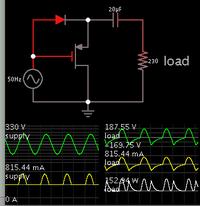KlausST
Advanced Member level 7
Hi,
When you use a diode to half wave rectify a 220V RMS sine you get a 155V RMS signal.
Additionally there is a DC component that may harm some devices...
Klaus
When you use a diode to half wave rectify a 220V RMS sine you get a 155V RMS signal.
Additionally there is a DC component that may harm some devices...
Klaus


